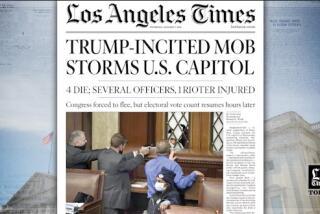Administration Fumbled Away Hopes for Tibet
- Share via
WASHINGTON — This is the account of one of President Clinton’s initiatives that got sidetracked and has led to nothing. It is a typical Washington tale, in which hopes are raised, political points are scored, headlines are written and then in the end an issue is quietly written off.
It is the sad story of the Clinton administration and the Dalai Lama.
In June 1998, during his visit to China, Clinton stood by proudly as Chinese President Jiang Zemin, at a televised press conference, seemed to suggest that he was open to a dialogue with the exiled leader of Tibet. A headline in The Times branded Jiang’s remarks “stunning.” A Clinton aide told the Washington Post that China had extended “an unusual olive branch.”
Just over a year later, those much-heralded efforts have gone nowhere.
As the Dalai Lama tours the United States this week, China shows no sign of any willingness to talk with him. Indeed, the regime has returned to its old habit of personal attacks. A Foreign Ministry spokesman recently called the Dalai Lama “a political exile engaged in the activities of splitting China.”
What happened to Clinton’s efforts?
The Tibet initiative has failed in the typical Washington way. The administration did not realize how tough the issue would prove to be. Clinton’s successful effort to avoid impeachment diverted energies. Important people changed jobs. Other China issues cropped up, forcing the White House to shift priorities. And so, without admitting it, the administration gave up.
The story began in the summer of 1997. Secretary of State Madeleine Albright, yielding to congressional demands, agreed to appoint a special coordinator at the State Department for Tibet policy. That fall, she filled the job with one of her top aides, Gregory Craig, the State Department’s director of policy planning.
Over the following eight months, the administration devoted more time and effort to Tibet than any of the previous five administrations. Craig was active, and Albright herself gave the issue top priority in dealing with Beijing. A National Security Council aide, Jeffrey Bader, explored chances for progress between China and the Dalai Lama.
These efforts appeared to pay off during Clinton’s trip. At the press conference, the president predicted that if Jiang met the Dalai Lama, “they would like each other very much.” The Chinese president answered that the door to dialogue was open if the Dalai Lama could say “that Tibet is an inalienable part of China and he must also recognize Taiwan as a province of China.”
Jiang’s tone and his notable refusal to denounce the Dalai Lama suggested a softening of China’s position and room for compromise. The Dalai Lama already had said that he does not seek outright independence from China.
But in the months after Clinton returned to Washington, the administration failed to follow up quickly on Tibet and, by the time it did probe for progress from Beijing, China had returned to a hard line.
The administration’s attention was elsewhere. In the fall of 1998, Congress was moving toward impeachment of the president. Clinton selected Craig as his special counsel, assigning him to “quarterback the response” to independent counsel Kenneth W. Starr’s charges.
Craig’s job of Tibet coordinator lay vacant for four months. Meanwhile, at the NSC, Bader was selected to be ambassador to Namibia, and Tibet was accorded less attention than it had received previously.
Early this year, Albright appointed a new Tibet coordinator, Julia Taft, who is also the assistant secretary in charge of refugees. This spring, when 1 million ethnic Albanian refugees fled Kosovo in the face of Serbian atrocities, Taft understandably was too busy to spend much time on Tibet.
Even without these significant personnel changes, it is likely that the administration would have been unable to make much headway on Tibet. The truth is that, in dealing with China, the White House has other priorities.
The administration wants to preserve the peace between China and Taiwan. It seeks China’s help in dealing with North Korea. It wants to work out a deal with Beijing for China’s admission to the World Trade Organization, a goal avidly sought by the American business community.
Recently, China has taken new steps toward tightening its control of Tibet. In June, it introduced to Tibet a 9-year-old boy the regime has chosen and is trying to install as the next Panchen Lama, Tibet’s second-ranking religious leader. The boy dutifully urged Tibetans to “love the Communist Party of China.”
And the Clinton administration? Its only recent action has been to dispatch Taft to New York City for a chat with the Dalai Lama last Friday.
The Tibetan leader is supposed to visit Washington next summer. You can bet that the president, Vice President Al Gore and First Lady Hillary Rodham Clinton all will turn out to greet him at the White House, as they did last month for the women’s World Cup soccer team.
Meeting with the Dalai Lama has become good American politics. Obtaining concessions from China that will change the situation in Tibet is not nearly so easy.
More to Read
Sign up for Essential California
The most important California stories and recommendations in your inbox every morning.
You may occasionally receive promotional content from the Los Angeles Times.













